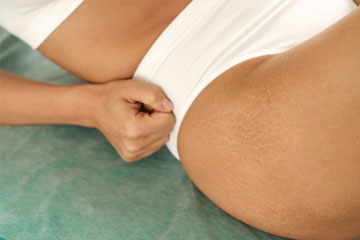A stretch mark is a type of scar that occurs when the skin stretches or shrinks quickly. The sudden and abrupt changes in the skin cause the collagen and elastin (which support the skin) to rupture. As the skin heals, stretch marks may appear. Also called striae, these long, thin and rippled marks will at first appear as thin or purple lines of a different texture than the skin around it. In most cases, these marks fade on their over time. Faded stretch marks become less noticeable and usually appear lighter in color than the surrounding skin.
These rippled, streaky lines on the skin appear in different colors and can appear on different parts of the body like the stomach or torso, breasts, hips, buttocks, shoulders, arms and thighs. People with fluctuating hormone levels are especially prone to developing stretch marks. Also, pregnancy can cause the condition. Other factors that tend to increase the risk of this skin condition include –
- Genetic factors
- Growth spurts that happen in puberty
- Pregnancy
- Rapid weight loss or gain
- Rapid muscle growth due to weight training
- Breast implant surgery
- High amounts of steroids (either from steroid medications or illnesses like Cushing’s syndrome)
- Marfan syndrome (a genetic disease that weakens skin fibers and causes unusual growth)
How to Get Rid of Stretch Marks?
Like other scars, stretch marks are permanent. However, treatment may reduce the itchiness symptoms and make these scars less noticeable. It is important to understand that no single treatment option works for everyone. A combination of treatment options and home remedies may provide the desired results. Here are some of the common treatment options that can help reduce the symptoms of stretch marks –
- Stretch mark creams, lotions, and gels – Researchers have discovered that many of the creams, lotions, and gels can treat stretch marks. While no one product seems to fully cure the marks, they can reduce their appearance and color. Lotions or gels must be used on early stretch marks. Massaging the product gently on to the skin may make it more effective. Apply these products daily or continuously for a specific period of time as the results may take a considerable amount of time to appear.
- Self-tanner – A self-tanner can camouflage both early and mature stretch marks. However, it is important to understand that a self-tanner cannot fully get of rid of stretch marks.
- Prescription medicines – Medicines that contain ingredients like hyaluronic acid Tretinoin can be effective on stretch marks. Often used in creams, lotions, and serums, hyaluronic acid is a powerful ingredient for moisturizing and skin healing. It is effective on early stretch marks and makes them less noticeable. On the other hand, Tretinoin is a retinoid which may also make early stretch marks less noticeable.
- Dermatology procedures – Dermatologists use a combination of procedures like – chemical peel, laser therapy, microdermabrasion, radiofrequency and ultrasound – to make stretch marks less noticeable. It may also help the skin produce more collagen. However, none of these procedures can fully get rid of stretch marks.
- Home remedies – Certain home remedies can fade or hide stretch marks. However, there is no solid proof that these remedies will produce effective results. Common home remedies that can reduce the symptoms of stretch marks include – massaging or applying almond oil, cocoa butter, olive oil, or vitamin E into the marks.
Controlling your weight, staying hydrated, and eating a nutritious diet may prevent the appearance of stretch marks. If you are bothered about your stretch marks, talk to your physician about treatment options.
